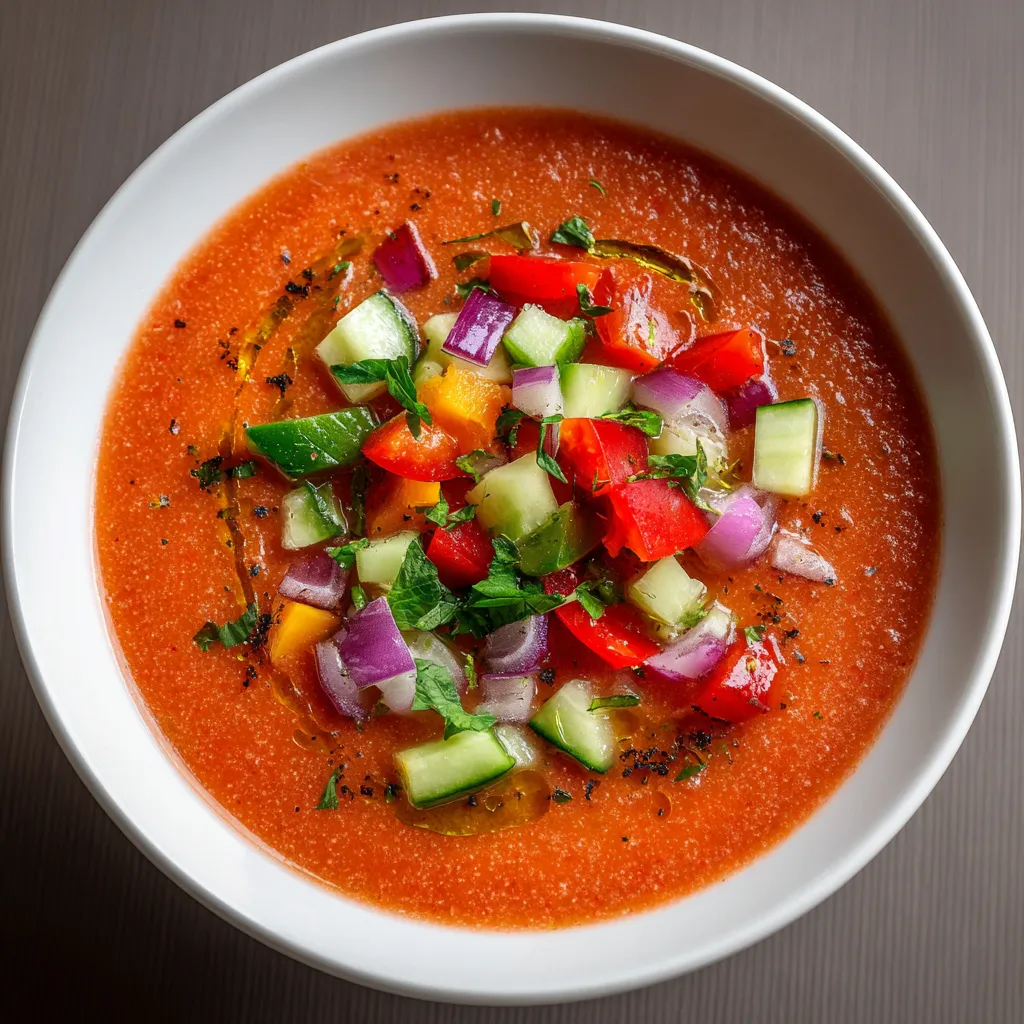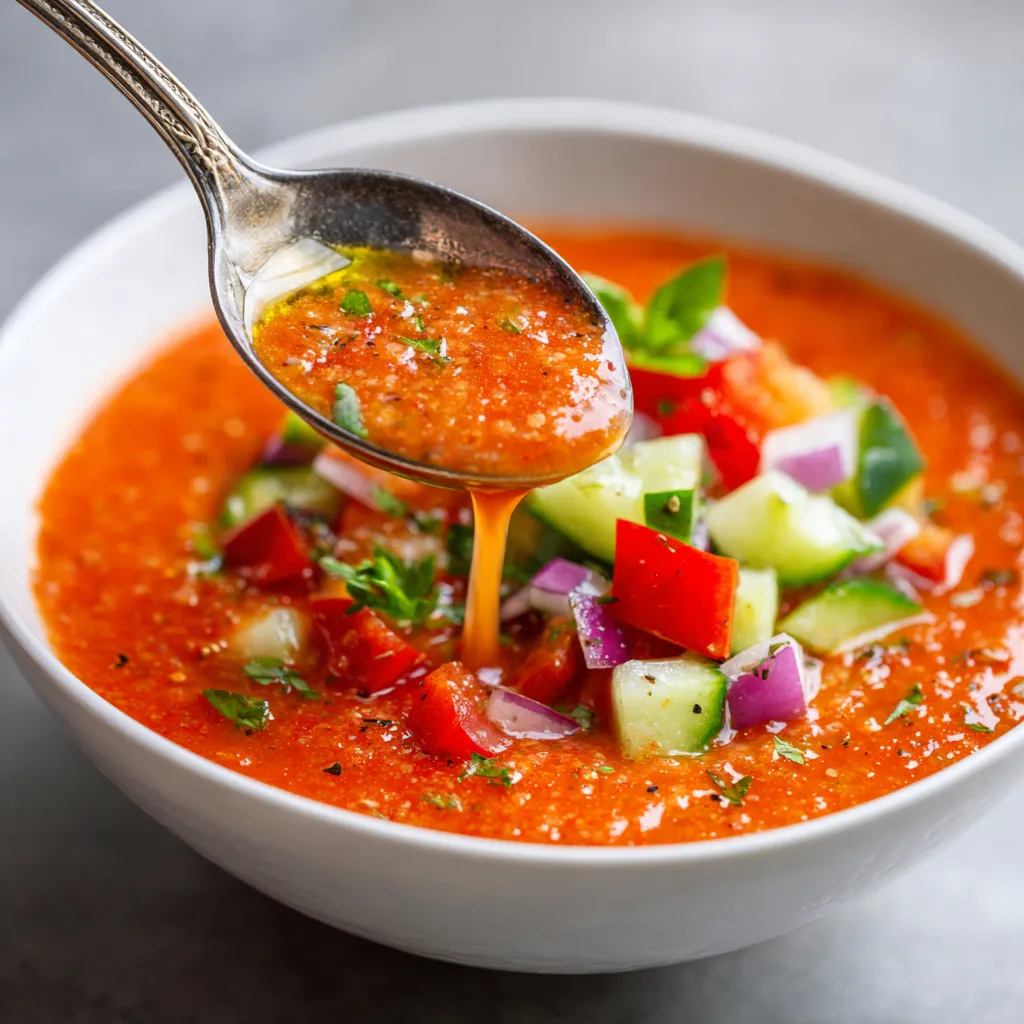 Save to Pinterest
Save to Pinterest Classic gazpacho is the ultimate dish for a sweltering day when you crave something cooling yet deeply flavorful. Crisp vegetables and fresh bread transform into a silky soup that brings the taste of Spanish summer right to your table. This easy and nourishing vegan recipe lets the best of late summer produce shine, delivering a satisfying meal or starter that needs no cooking and rewards a little patience with incredible flavor after chilling.
I first tried gazpacho during a hot week in Seville. The cold, tangy soup was so refreshing that it quickly became my top choice whenever tomatoes are at their best and my kitchen feels too warm to turn on the stove.
Ingredients
- Ripe tomatoes: These are the heart of gazpacho. Go for the juiciest, brightest tomatoes you can find, especially in summer for maximum flavor.
- Cucumber: Adds coolness and crunch. Seedless varieties are best, but any will do; just peel and take out seeds for a smooth soup.
- Red and green bell pepper: Both bring sweetness and mellow zing. Choose firm, glossy peppers without soft spots.
- Red onion: Gives bite and color. Look for smaller onions and keep flavors balanced by not using too much.
- Garlic: Provides an essential aromatic punch. Fresh cloves only for that spicy kick.
- Extra virgin olive oil: Rounds out the soup and adds richness. Go for a fruity Spanish blend if possible.
- Sherry vinegar: Brings brightness. Traditional in Spain but red wine vinegar works in a pinch. Look for good quality aged vinegar for depth.
- Sea salt and black pepper: Essential for seasoning. Start with a little and taste as you go.
- Country bread: Helps thicken and emulsify. Use bread that is a day or two old and chewy with some substance.
- Cold water: Gives the soup its refreshing, light texture. Add as needed to reach your favorite consistency.
- Cumin: Optional but brings gentle warmth and earthy background notes. Spanish ground cumin is most fragrant.
- Fresh herbs: For garnish. Parsley or basil and a drizzle of olive oil finish the soup beautifully. Choose fresh, unwilted leaves.
Step-by-Step Instructions
- Soak the Bread:
- Tear your day-old bread into pieces and put in a bowl. Add one cup cold water. Let it sit for two minutes, just enough to soften. Squeeze out most of the liquid. Then tear into rough bits so it blends smoothly but still brings creamy body to your soup.
- Blend the Soup Base:
- Place the soaked bread, chopped tomatoes, cucumber, both bell peppers, onion, garlic, olive oil, vinegar, salt, pepper, and cumin if using into a blender or food processor. Blend until everything is completely smooth. This creates a creamy, almost silky soup. Let it run for at least a minute to break down any vegetable bits.
- Taste and Adjust:
- Pause and try a spoonful. Adjust with extra salt, vinegar, or olive oil to taste. If the mixture feels very thick, add a splash or two of cold water until you get that pourable but not watery consistency you crave.
- Chill Thoroughly:
- Pour your soup into a big bowl. Cover and put in the fridge for two hours at least. The cold time is crucial for melding flavors and creating that true Spanish gazpacho experience.
- Serve and Garnish:
- Give the finished soup a good stir before ladling into bowls. Top with diced cucumber, red bell pepper, a sprinkle of red onion, and torn fresh parsley or basil. Drizzle with a touch of extra olive oil. Serve immediately for a refreshing start to your meal.
 Save to Pinterest
Save to Pinterest Gazpacho was always part of my family’s summer trips to southern Spain. The flavor of ripe tomatoes and good olive oil brings back memories of lazy afternoons and the vibrant colors of local produce.
Storage Tips
Keep leftover gazpacho in a tightly covered jar or container in the fridge. It stays fresh for up to three days. In fact, the flavor often improves overnight. If you notice separation, just stir well before serving.
Ingredient Substitutions
You can use yellow or heirloom tomatoes for a fun color twist. If you do not have sherry vinegar, red wine vinegar or even white wine vinegar can work. Gluten-free bread makes the recipe accessible to everyone. If you want extra richness, try a few roasted red peppers instead of fresh.
Serving Suggestions
Serve the soup in chilled small bowls or glasses for appetizers. It pairs well with a simple salad, garlicky croutons, or Spanish tapas like tortilla de patatas. For a heartier meal, enjoy alongside a grilled vegetable sandwich.
 Save to Pinterest
Save to Pinterest A Bit of History
Gazpacho originated in southern Spain as a humble peasant dish meant to use up stale bread and garden vegetables. Over centuries, it has evolved from a garlic bread and oil base to the bright tomato-forward version we know today. Every region and household adds its own twist, sometimes with more vinegar or with a completely different vegetable mix, but the refreshing spirit remains the same.
Common Recipe Questions
- → What kind of tomatoes work best for gazpacho?
Use very ripe, in-season tomatoes for maximum sweetness and flavor. Plum or vine-ripened are ideal.
- → How long should gazpacho chill before serving?
Allow at least two hours in the refrigerator for the flavors to develop and the soup to become ice cold.
- → Can I make gazpacho gluten-free?
Yes, simply substitute gluten-free bread or omit it for a naturally gluten-free soup.
- → Do I need to peel tomatoes for gazpacho?
Peeling is optional. For an ultra-smooth texture, you can peel and deseed, but it's not required.
- → What garnishes pair well with gazpacho?
Diced cucumber, bell pepper, red onion, fresh basil or parsley, and an extra drizzle of olive oil are all great options.
- → Can gazpacho be made ahead?
Absolutely. Gazpacho tastes even better after chilling overnight, making it perfect for advance preparation.